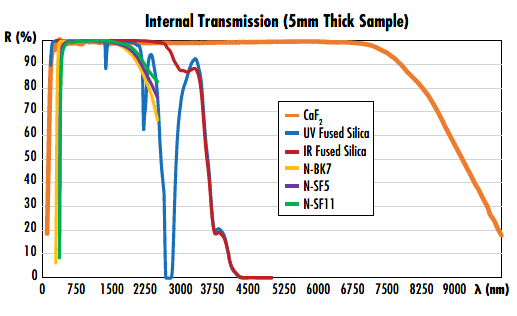Common Laser Optics Materials
This is Section 8.9 of the Laser Optics Resource Guide.
Understanding the most commonly used laser optics materials will allow for easy navigation of Edmund Optics’ wide selection of laser optics components. Table 1 below lists common substrates used for laser optics, along with their key properties, followed by transmission curves for each material. All values in Table 1 are at 1064nm and 20° C and all transmission curves show the internal transmission of 5mm thick substrates without Fresnel reflections. Transmission data was gathered using Edmund Optics’ spectrophotometers.
| Material | Transmission Range (nm) | Index of Refraction (n) | Abbe Number (v) | Group Velocity Dispersion (fs2/mm) | dn/dT (10-6/K) |
Coefficient of Thermal Expansion (10-6/K) | Relative Price |
|
CaF21 |
200nm - 7μm |
1.429 |
95.1 |
17.280 |
-10.6 |
8.85 |
$$$ |
| UV Grade Fused Silica (Corning HPFS® 7980)2 | 185nm - 2.1µm | 1.450 | 67.8 | 16.476 | 9.6 | 0.55 | $$ |
| KrF Grade Fused Silica (Corning HPFS® 7980)2 | 185nm - 2.1µm, T ≥ 99.9% @ 248nm | 1.450 | 67.8 | 16.476 | 9.6 | 0.55 | $$$ |
| IR Grade Fused Silica (Corning HPFS® 7979)2 | 300nm - 3.5µm | 1.451 | 67.8 | 16.476 | 9.7 | 0.55 | $$($) |
| N-BK73 | 350 - 2000nm | 1.507 | 64.2 | 22.369 | 3.0 | 7.1 | $ |
| N-SF53 | 330 - 2500nm | 1.651 | 32.3 | 77.779 | 3.4 | 7.9 | $ |
| Sapphire*4 | 200 - 5500nm | 1.755 | 72.2 | 28.588 | 13.1 | 5.4 | $$$ |
| N-SF113 | 400 - 2500nm | 1.754 | 25.8 | 118.44 | 2.4 | 8.5 | $ |
*Sapphire is a birefringent material and all specifications correspond parallel to C-Axis
Table 1: Common laser optics substrates and their key properties (all values at 1064nm and 20° C). Materials are listed from smallest refractive index to largest refractive index. The small dollar sign by KrF grade fused silica indicates that it is slightly more expensive than UV grade fused silica. SImilarly, the small dollar sign in parentheses by IR grade fused silica indicates that it is sometimes slightly more expensive than UV grade fused silica, but it is almost never cheaper

Figure 1: Internal transmission curves for common laser optics materials with no Fresnel reflections
More information on key properties of optical glass types can be found in our Optical Glass application note and information specific to materials for infrared applications can be found in our Correct Material for Infrared Applications application note, although not all of these materials are compatible with laser systems.
References
- I. H. Malitson. “A redetermination of some optical properties of calcium fluoride,” Appl. Opt. 2, 1103-1107 (1963)
- “Corning HPFS® 7979, 7980, 8655 Fused Silica.” Corning, February 2014.
- “Optical Glass Data Sheets.” Schott, February 2014.
- I. H. Malitson. “Refraction and dispersion of synthetic sapphire,” J. Opt. Soc. Am. 52, 1377-1379 (1962)
- Collier, David, and Rod Schuster. “Superpolishing Deep-UV Optics.” Photonics Spectra, February 2005.
More Resources
- Optical Glass
- Edmund Optics Preferred Glass Types
- UV vs. IR Grade Fused Silica
- The Correct Material for Infrared (IR) Applications
- Absorption
- Optical Glass
- Thermal Properties of Optical Substrates
- Homogeneity and Scatter from Inclusions and Bubbles
- Dispersion
- Subsurface Damage
- Common Laser Optics Materials
- Laser Optics Lab Video Series













 Previous Section
Previous Section 















or view regional numbers
QUOTE TOOL
enter stock numbers to begin
Copyright 2023, Edmund Optics Inc., 101 East Gloucester Pike, Barrington, NJ 08007-1380 USA
California Consumer Privacy Acts (CCPA): Do Not Sell or Share My Personal Information
California Transparency in Supply Chains Act